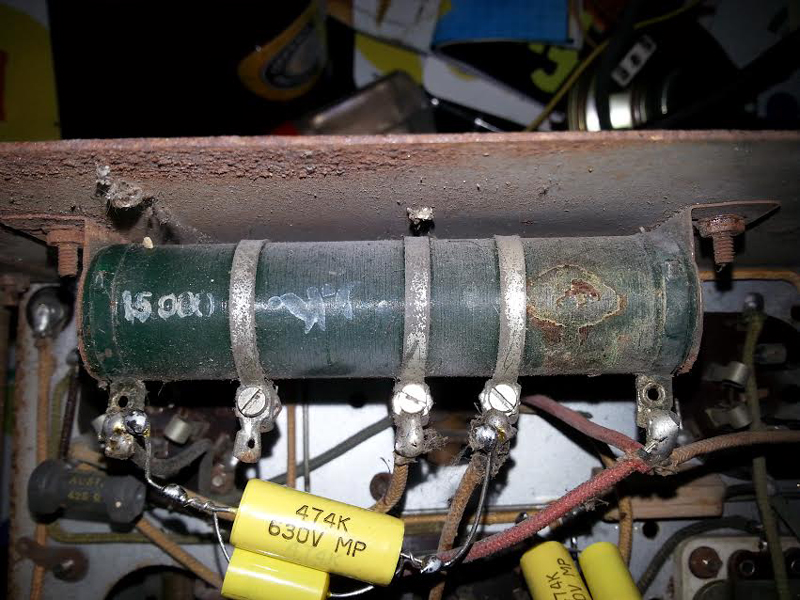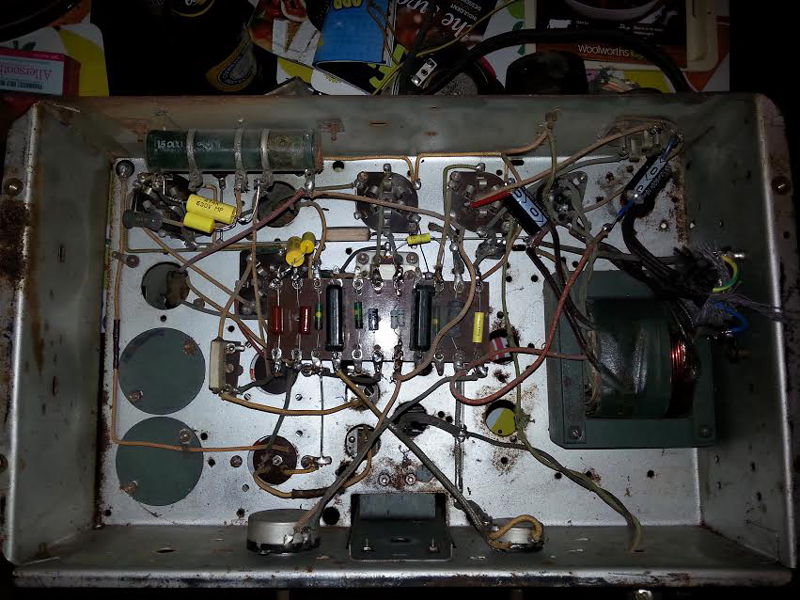Tech Talk
Forum home - Go back to Tech talk
|
1939 Lekmek 540 going Pweeeeeee!
|
|
|
Return to top of page · Post #: 1 · Written at 7:40:18 PM on 18 June 2017.
|
|
|
|
Location: Clare, SA
Member since 27 March 2016 Member #: 1894 Postcount: 513 |
|
Hi. |
|
|
Return to top of page · Post #: 2 · Written at 8:06:19 PM on 18 June 2017.
|
|
|
|
Location: Albury, NSW
Member since 1 May 2016 Member #: 1919 Postcount: 2048 |
|
Stain marks Jamie?? |
|
|
Return to top of page · Post #: 3 · Written at 9:02:18 PM on 18 June 2017.
|
|
|
|
Location: Clare, SA
Member since 27 March 2016 Member #: 1894 Postcount: 513 |
|
Like furniture stain I'm guessing, a round mark as if a small bottle sat with stain leaking? Same colour as the dark wood stain I've been sanding back to get to original light coloured wood. |
|
|
Return to top of page · Post #: 4 · Written at 9:20:42 PM on 18 June 2017.
|
|
|
|
Location: Albury, NSW
Member since 1 May 2016 Member #: 1919 Postcount: 2048 |
|
3 tea spoons of Oxalic Acid in a small glass of warm water will return the veneer back to its natural colour and then you can stain it again or oil etc etc |
|
|
Return to top of page · Post #: 5 · Written at 9:47:12 PM on 18 June 2017.
|
|
|
|
Location: Clare, SA
Member since 27 March 2016 Member #: 1894 Postcount: 513 |
|
Yes Pete, top coats are off, I'm in bare wood, just stained. Thanks for that tip! I shall get some as there are other bits and hard to get into corners and that will help immensely! Cheers. |
|
|
Return to top of page · Post #: 6 · Written at 9:51:19 PM on 18 June 2017.
|
|
|
|
Location: Albury, NSW
Member since 1 May 2016 Member #: 1919 Postcount: 2048 |
|
It will remove all the stains that have been put on the timber and it will return it back to its natural colour. Is the timber oak ? |
|
|
Return to top of page · Post #: 7 · Written at 10:28:51 PM on 18 June 2017.
|
|
|
|
Location: Clare, SA
Member since 27 March 2016 Member #: 1894 Postcount: 513 |
|
I believe it is and I've bought oak stain to re-stain it prior to varnish coats, I just want it back to uniform bare wood. I've got to get some glue and filler for the rear bottom of the cabinet where the plywoods gone like bad wafers right at the bottom and glue and clamp it, then fill and sand again before staining. |
|
|
Return to top of page · Post #: 8 · Written at 10:31:43 PM on 18 June 2017.
|
|
|
|
Location: Hill Top, NSW
Member since 18 September 2015 Member #: 1801 Postcount: 2230 |
|
Sounds like you have a feedback path in the audio section. Without a schematic I can only guess. Is there a connection from the speaker transformer secondary back into the amplifier? Do the wires from the primary pass close to the detector or volume control? |
|
|
Return to top of page · Post #: 9 · Written at 11:00:38 PM on 18 June 2017.
|
|
|
|
Location: Albury, NSW
Member since 1 May 2016 Member #: 1919 Postcount: 2048 |
|
Must be English Oak! |
|
|
Return to top of page · Post #: 10 · Written at 11:11:37 PM on 18 June 2017.
|
|
|
|
Location: Clare, SA
Member since 27 March 2016 Member #: 1894 Postcount: 513 |
|
No feedback coupling from the transformer, but as for the other I'll need to check, sounds like feedback oscillation. |
|
|
Return to top of page · Post #: 11 · Written at 6:26:02 PM on 25 June 2017.
|
|
|
|
Location: Clare, SA
Member since 27 March 2016 Member #: 1894 Postcount: 513 |
|
Well I spent a few hours more on it checking and replacing resistors, but it's still going Phweeeeee! So I have some new valves coming so hopefully a new 6A7 and 6D6 might sort it out as the amp stage is working well, just nothing from the radio side? I have a brand new 75 valve in there and the 42 and 80 are good, so it's got to be something else. I've got an oscilloscope now, I just need to figure out how to use it to check for signal. |
|
|
Return to top of page · Post #: 12 · Written at 7:01:35 PM on 25 June 2017.
|
|
|
|
Location: Latham, ACT
Member since 21 February 2015 Member #: 1705 Postcount: 2220 |
|
That sounds like a problem I had with my Little Nipper a while back. Is there a back bias supposed to be there but isn't. Can we have a picture of under the chassis? |
|
|
Return to top of page · Post #: 13 · Written at 9:06:40 PM on 25 June 2017.
|
|
|
|
Location: Wangaratta, VIC
Member since 21 February 2009 Member #: 438 Postcount: 5646 |
|
Are you running that with, or without valve shields? 6D6 is actually the same valve as 6U7 with different bases & that also applies to 6A7 & 6A8. |
|
|
Return to top of page · Post #: 14 · Written at 9:42:24 AM on 26 June 2017.
|
|
|
|
Location: Toongabbie, NSW
Member since 19 November 2015 Member #: 1828 Postcount: 1385 |
|
Jamie, I agree 100% with Marcc, having had experience with 58/6D6 valves in superhets. |
|
|
Return to top of page · Post #: 15 · Written at 8:43:36 PM on 27 June 2017.
|
|
|
|
Location: Clare, SA
Member since 27 March 2016 Member #: 1894 Postcount: 513 |
|
Cheers, yes there are shields which seem ok, but I will check them as you suggested. With the oscilloscope, where do I check for signal/oscillation? I have a ground wire and a probe, can I connect the probe to the plate? Will the oscilloscope be ok with the high voltages? I don't want it damaged. I will take some photo's in the morning when I fire up the chassis with the speaker and new valves fitted and the antenna connected. Hopefully I'll get a station. It has a long wire round resistor with tappings, with 15,000 ohm written on it, yet can't get continuity trying to measure resistance anywhere on it, yet with power, I have 309 volts at one end, 4 volts at the first tapping and one volt at the next and one volt at the other end, maybe it's oc? not sure.. I'll photograph it.   |
|
|
You need to be a member to post comments on this forum.
|
|

Sign In

Vintage Radio and Television is proudly brought to you by an era where things were built with pride and made to last.
DISCLAIMER: Valve radios and televisions contain voltages that can deliver lethal shocks. You should not attempt to work on a valve radio or other electrical appliances unless you know exactly what you are doing and have gained some experience with electronics and working around high voltages. The owner, administrators and staff of Vintage Radio & Television will accept no liability for any damage, injury or loss of life that comes as a result of your use or mis-use of information on this website. Please read our Safety Warning before using this website.
WARNING: Under no circumstances should you ever apply power to a vintage radio, television or other electrical appliance you have acquired without first having it checked and serviced by an experienced person. Also, at no time should any appliance be connected to an electricity supply if the power cord is damaged. If in doubt, do not apply power.
Shintara - Keepin' It Real · VileSilencer - Maintain The Rage
